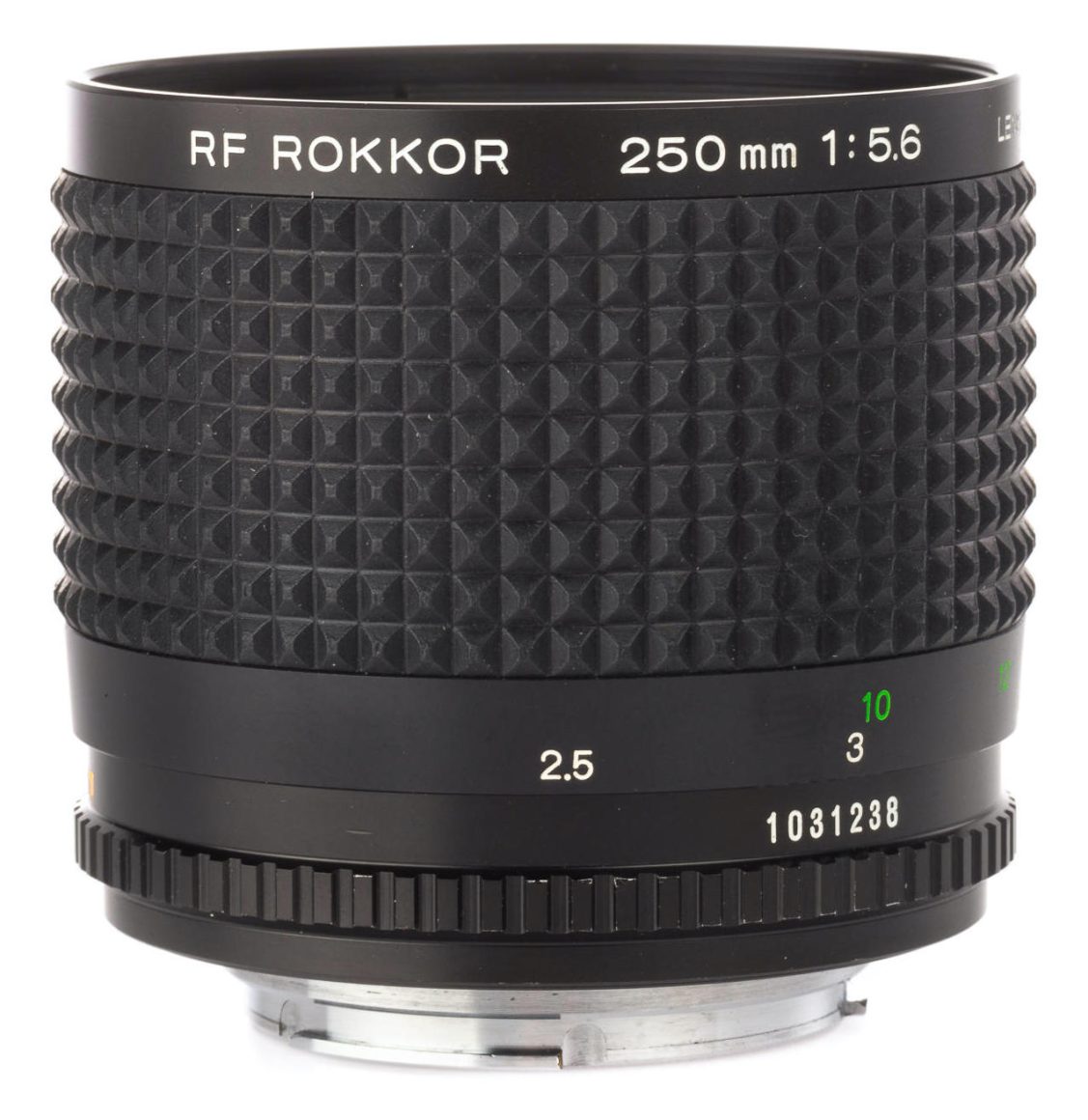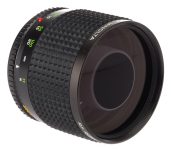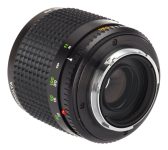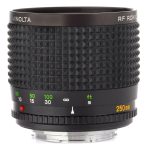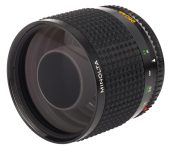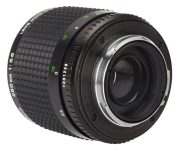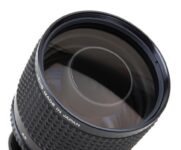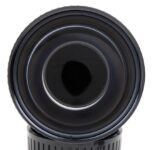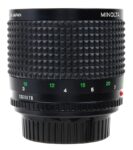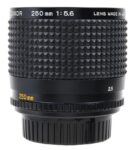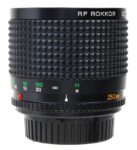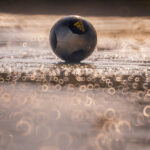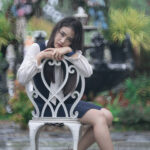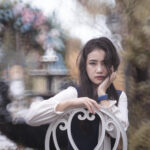Minolta RF Rokkor 250mm F/5.6
Medium telephoto prime lens • Film era • Discontinued
- Announced:
- · June 1979
- Production status:
- ● Discontinued
- Country of design:
- · Japan
- Original name:
- · MINOLTA RF ROKKOR 250mm 1:5.6
- Class:
- · Slow full-frame medium telephoto prime lens
- · Mirror/Reflex lens
- System:
- · Minolta SR (1958)
Specification
| Optical design: | |
| 35mm full frame | |
| 250mm | |
| F/5.6 | |
| 6 elements in 5 groups | |
| Minolta SR [43.5mm] | |
| 9.9° (35mm full frame) | |
| Diaphragm mechanism: | |
Diaphragm type: | Fixed |
Aperture control: | None |
| Focusing: | |
| 2.50m | |
| <No data> | |
Focusing modes: | Manual focus only |
Manual focus control: | Focusing ring |
| Physical characteristics: | |
| 250g | |
| ⌀66.5×58mm | |
| Accessories: | |
| Screw-type 62mm | |
| Rear screw-type 39mm | |
| Screw-type round | |
| Minolta MD 2X Tele Converter 300-S → 500mm F/11.2 |
Sources of data
- Minolta lenses: vision for the creative photographer booklet.
- A guide to the Minolta SLR system of creative photography 0411-K7 (1984).
- Minolta Corporation Photographic Division 1981/1982 Catalog (March 1981).
- A guide to the Minolta SLR system of creative photography 0209-F1.
Manufacturer description #1
This super-compact telephoto is nearly the same size and weight as a standard 50mm lens but with five times greater magnification. Using state-of-the-art computer-designed optics, Minolta has produced the lightest, most compact telephoto of its kind.
Manufacturer description #2
A different kind of telephoto lens is the catadioptric design, that folds the light path via high-quality-optical mirrors in combination with conventional refractive lens elements. Minolta makes four of these - the 250mm F/5.6 RF, 500mm F/8 RF, 800mm F/8 RF and 1600mm F/11 RF - and each is outstanding in terms of fantastic reach and a surprisingly lightweight design. These super telephoto lenses are indispensable for sports, nature and landscape photography. The 250mm F/5.6 RF is the world's first reflex-type medium telephoto lens, a beauty to handle. The 500mm F/8 RF is one of the smallest, lightest of its focal length available to the photographers today, and makes long-telephoto photography a hand-held situation. This superb Minolta lens weighs only 600g and is hardly larger than a conventional medium telephoto lens. The 800mm F/8 RF also features a compact size for such a long focal length, which contributes to convenient handling portability. The 1600mm F/11 RF is the longest Minolta lens of all, providing phenomenal telephoto capabilities. All of the mirror-type lenses have built-in filters that are rear-mounted for additional versatility. With the use of the built-in ND (Neutral Density) filter, for instance, the amount of light passing through each lens may be reduced.
From the Modern Photography magazine
Not too long ago, Minolta's optical wizards delivered themselves one of the smallest and lightest 500mm mirror lenses yet seen. Unseen, however, was an even smaller cat - call it a kitten - held in the sleeve of the corporate kimono. Would you believe a 250mm mirror lens weighing less than 10 oz., roughly comparable to a fast 50mm normal lens, with a very respectable f/5.6 aperture?
The 250mm "kitten" contains two mirrors, three correcting lenses and a filter. The formula is quite similar to Minolta's excellent 500mm f/8 mirror. The lightweight, satin-finished black mount focuses from infinity to 8 1/4 ft. in an exceptionally smooth 210° turn of the rubber-ribbed, 1 1/4- in.-wide focusing ring. At the closest focusing distance the field coverage was 8 1/2 x 13 in. just about right for a tight head shot. Distances are easily read in feet and meters, marked in green and white.
In practice, the tele was a joy to carry and a pleasure to use. Focusing at f/5.6 was easy and decisive. Sharp results were obtained with the lens hand-held at shutter speeds appropriate to the focal length (1/250 sec. and faster). With due care and proper bracing, even slower speeds were satisfactory. The use of high-speed films is desirable to keep hand-held speeds as high as possible. The use of the ND 4 filter supplied with the lens may be necessary with high-speed films in bright daylight, to avoid overexposure. This will, of course, change the effective lens aperture to f/11, requiring more care in focusing. Note that this will not increase the depth of field (or permissible margin of focusing error) since the ND filter changes the transmission only. There is no diaphragm for stopping down.
The rear-mounted filters are interchanged with a special wrench supplied with the lens; an easy operation taking but a moment. The filters are the same ultra-flat 39mm types used on the 500mm mirror Rokkor also available are ND 8 (four stops) yellow, red, and orange optional accessory filters.
Certainly, this Rokkor-X 250 provides photographers with a traveling telephoto with good reach and minimal bulk.
Typical characteristics of mirror (reflex) lenses
- Catadioptric system consisting of curved mirrors and optical glass;
- Much shorter, lighter and less expensive designs than conventional super telephoto lenses;
- Outstanding correction of chromatic aberrations;
- Since the aperture is fixed, neutral density filters are used to obtain a smaller aperture;
- Doughnut-shaped out-of-focus highlights.
From the editor
The lens was supplied with Normal and ND4x rear 39mm screw-type filters.
Lenses with similar focal length
| ■Interchangeable mount (2) | |||||||||
| Zoomar Muenchen Reflectar 250mm F/4 | -- | 3 - ? | 2.00m | -- | 1970 ● | ||||
| Lentar 250mm F/5.6 Mirror [T] | -- | ? - ? | 2.10m | ● | |||||
